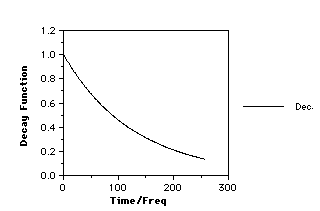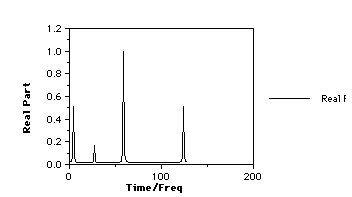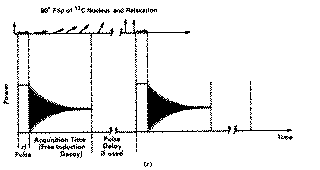 ).
Another phasing error due to technical imperfections in the spectrometer is
often referred to as the zero order phase correction. These are both
applied to F(
).
Another phasing error due to technical imperfections in the spectrometer is
often referred to as the zero order phase correction. These are both
applied to F( ) after the FT is complete.
) after the FT is complete.To obtain good spectra free from too much electronic noise, it is common to add together between 8 - 800 FIDs, a process which takes between ~30 seconds to 24 hours. Over that sort of period the field frequency may drift slightly, resulting in poor averaging. To compensate for this, most FT spectrometers have special "lock circuitry" based on detecting a deuterium signal. For this to work, the solvent used MUST contain deuterium! Normally CDCl3 is used, but deuterated acetone or DMSO are also common, and "locking" the sample is normally the first operation actually performed on the spectrometer, and further the "lock signal" is also used to "shim" the spectrometer, ie adjust the homogeneity of Bo. Note that carbon tetrachloride should not be used as a solvent for this reason.
At the end of the short radio frequency
pulse tp, the precession of all the nuclei in the magnetic field was
effectively in phase. Provided measurement of the resultant induced signal in
the y axis starts immediately afterwards, all the initial measured sine wave
responses would also be in phase. However, no NMR spectrometer yet
constructed can achieve this and for electronic reasons, a short delay
between the end of tp and start of measurement is required. The short
delay means measurement begins when the sine waves are already out of phase.
This so called first order phase error can be calculated from a
suitable combination of the real and imaginary components of F( ).
Another phasing error due to technical imperfections in the spectrometer is
often referred to as the zero order phase correction. These are both
applied to F(
).
Another phasing error due to technical imperfections in the spectrometer is
often referred to as the zero order phase correction. These are both
applied to F( ) after the FT is complete.
) after the FT is complete.
With the measurement
of a single FID resulting from one pulse, followed by Fourier Transformation
to give F( ), one can achieve a spectrum approximately equivalent in
its noise level to a CW spectrum which took 600 or more seconds to record! By
adding n FID measurements together in the computer, one can reduce the noise
by ˆn, ie 64 FIDs added together (and taking 3.41*64= 3.6 minutes)
will reduce the noise by almost a factor of 10. It also turns out that one
can multiply the whole of f(t) by a new function such as a decaying
exponential prior to the FT operation. Surprisingly, this does NOT introduce
any new frequencies, but can dramatically reduce the noise level at the
expense of making the resulting peaks broader. This is because a faster f(t)
decay corresponds to a shorter relaxation time T, a larger 1/T, and hence
wider peaks (cf 14N discussed in a later lecture
course).
), one can achieve a spectrum approximately equivalent in
its noise level to a CW spectrum which took 600 or more seconds to record! By
adding n FID measurements together in the computer, one can reduce the noise
by ˆn, ie 64 FIDs added together (and taking 3.41*64= 3.6 minutes)
will reduce the noise by almost a factor of 10. It also turns out that one
can multiply the whole of f(t) by a new function such as a decaying
exponential prior to the FT operation. Surprisingly, this does NOT introduce
any new frequencies, but can dramatically reduce the noise level at the
expense of making the resulting peaks broader. This is because a faster f(t)
decay corresponds to a shorter relaxation time T, a larger 1/T, and hence
wider peaks (cf 14N discussed in a later lecture
course).
Other more
complex functions (weighting functions) can actually decrease apparent peak
width, this time at the expense of the noise level. The effects of such
functions, as well as first order phase and non-Nyquist sampling errors etc
are readily demonstrated using a relatively short computer program. Such a
program is in fact described as one of the Fortran programming course
projects, the output of which is shown below;
Summary
We have set out how a short
pulse of electromagnetic radio frequency radiation can establish a resonance
with precessing nuclei in an applied magnetic field, and in doing so
establish a coherent phased precession which effectively tilts the precessing
magnetisation vector away from the axis of the applied field by a certain
angle called the pulse angle. This induces a response in a detector which is
measured as a function of time and can be converted to a more readily
interpreted frequency domain signal by digitisation and Fourier
Transformation. A whole range of more sophisticated experiments can be
derived from this simple one by varying the pulse angle, adding extra pulses
and inserting time delays, the entire assemblage being called a pulse
sequence. Description of these experiments is beyond the present scope of
the lectures, but some will be described in third year lectures.

Return to Index page